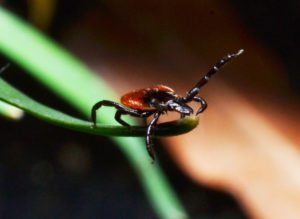As warmer weather comes to the south, ticks are coming out in full force! With our four legged friends running around outside, it’s a big possibility they could come back with ticks. Here are some prevention tips that will help keep ticks off of your pets and out of your home. We also talk about what to do if you find a tick on your pet! If you want to know what to do if you find a tick on yourself, click here!
What are ticks?
If you’ve seen a small, engorged insect on your pet, it could have been a tick. Ticks will latch onto your pets when they run through tall grasses or other wooded areas. They like to climb tall blades of grass and support themselves with their back legs while reaching out with their front legs in an attempt to latch onto a host. They’ve also been known to free fall from trees, and the National Pest Management Association even said there are some tick species that will follow their chosen host on foot until they can hop aboard!

Ticks are biting arachnids that are classified as an ectoparasite or an “external parasite.” There are over 200 species of ticks in the US according to the NPMA, but these 200 species can be broken down into the following two categories: hard ticks and soft ticks. Hard ticks feed on humans, pets and nuisance wildlife while soft ticks mostly feed on bats and birds. All tick species have the same life cycle: egg, larva, nymph, and adult. The larva will only have six legs while the nymphs and adults have eight legs. Although the life cycle is generally the same, the length of the cycle will depend on the species. Some ticks can live up to two years while others can live for as little as two months. They vary in shapes and sizes, but generally speaking, they are small and wingless with colors ranging from black to yellow and more.
If I find a tick, what should I do?
Ticks are known for carrying lyme disease and other dangerous pathogens. The way these pathogens spread is through the tick’s saliva, and the longer a tick is attached, the higher chance there is of contracting a disease. Removing the tick as fast as possible is the best solution. That means you should not use home remedies like essential oils or nail polish to try and drown or suffocate the tick. To safely and effectively remove a tick from your pet, the American Kennel Club (AKC) advised using a pair of fine tipped tweezers.

Part your pet’s fur and, using the tweezers, grasp the tick as close to the surface of the skin as possible. Then, gently pull up with steady, even pressure. Do not twist as that can cause the tick to break apart. Even if you remove the tick as advised, there may be parts of the tick’s mouth still left in the skin. In which case, you can try to remove the leftover bits with clean tweezers, but if you are unable to get the mouth parts out, leave the bite alone and let it heal on its own. One thing you should never do is remove an attached tick with your fingers. It could squeeze more infectious material out and expose you to pathogens.
After removing the tick, clean the bite and tweezers with rubbing alcohol or some other antiseptic and dispose of the tick. You can flush it down the toilet, place it in a sealed plastic bag or tape it tightly. If you notice that your pet is experiencing fever, lethargy, lameness or change in appetite, notify your vet immediately. According to the AKC Canine Health Foundation, it could take months for these symptoms to appear.
Tick prevention
The key to guarding yourself and your pet from tick borne illnesses is prevention! By protecting yourself from these biting arachnids, you are also guarding yourself from mosquitoes and fleas!
Tips to protect you
- After hiking or spending time outdoors, take a shower. This is a great opportunity to inspect yourself for any ticks that might have latched onto you.
- Wear an EPA approved insect repellent containing DEET, picaridin, IR3535 or oil of lemon eucalyptus.
- When outside, wear long-sleeved shirts and pants to limit your skin’s exposure to pests. Wearing light colored clothing will also help you more easily spot any ticks that are on your clothes.
Tips to protect your pet
- Give your dog a bath after spending time outdoors in wooded areas and in areas with tall grass. It’s a great way to do a tick inspection!
- Make sure you are using a flea and tick medication as prescribed from your veterinarian.
- Keep your grass cut short to take away a tick’s habitat. Tall grasses are a tick’s favorite place to search for new hosts!

